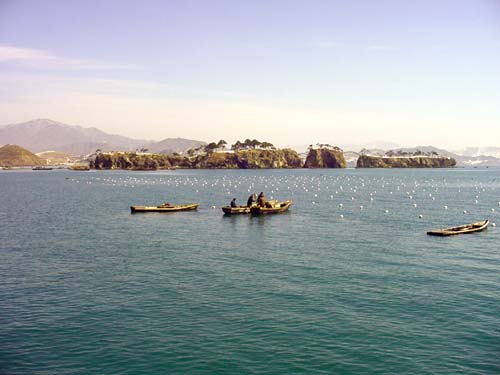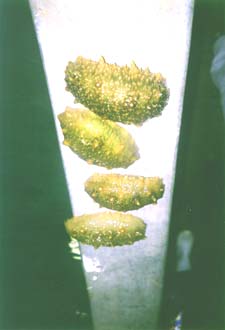
Chen Jiaxin, FAO Consultant, China PR
View of the sea area in the vicinity of the Hongwon Fisheries and Maricultures Cooperative. Cooperative members attending polyculture longlines
Alessandro Lovatelli1
Kim Myong Hyok2
A medium income industrialized country, the Democratic People's Republic of Korea (DPR Korea), with a population of about 30 million, is predominantly mountainous with 15 percent of total land area utilized for agriculture. Livestock has a relatively minor contribution to food production where only 0.3 percent of landmass is used for permanent and improved pastures. Because of these limitations of arable land and livestock production, aquaculture and fisheries have played an important role in the livelihood of the North Koreans, whose rural population comprise about one third of the total population.
The Government has thus recognized the significant contribution of fisheries to the economy and food security and the potential for aquaculture to further contribute to food production both for local consumption and for export to generate additional revenues. This is particularly important for coastal dwelling population who have limited access to arable land and who derived much of their livelihood from sea-based fishing, foraging and aquaculture activities such as culture and harvest of mollusk bivalves, such as the short-necked clam (Ruditapes philippinarum), oysters (Crassostrea gigas), ark shell (Arca inflata) as well as a variety of seaweed species (Porphyra tenera; Gracilaria verrucosa) including the large Japanese kelp (Laminaria japonica).
There has been a great decline in domestic food production since the early 1990s due to successive natural disasters and input shortages, making the production below the level for minimum subsistence. The aquaculture sector was severely affected by the lack of feeds for hatcheries and fish ponds causing aquaculture production to drop by half from 13 500 tonnes in 1994 to 7 000 tonnes in 1996. In 2001, marine aquaculture production of 444 000 tonnes mainly from Laminaria seaweed decreased to 300 000 tonnes in 2002.
The FAO Technical Cooperation Project “Strengthening Marine Aquaculture Development”(TCP/DRK/3001), was implemented from January 2004 to December 2005, with the Ministry of Fisheries (MoFi) as the responsible government agency for project implementation, and with the overall objective of introducing and transferring the technology of sea cucumber aquaculture, scallop spat production and kelp-scallop-sea cucumber polyculture in the north-east coast of DPR Korea.
The major outcomes of the TCP include:
(a) Establishment of sea cucumber hatchery. The hatchery in the Hongwon Fishing and Mariculture Cooperative, with a floor space of 1 550 m2 is equipped with 36 spawning and juvenile rearing tanks, microalgae culture facilities, breeding equipment and laboratory facilities. The facility currently has the capacity to produce not only sea cucumber juveniles, but also kelp seedlings, scallop and ark shell spats and sea urchin spawns. One million sea cucumber juveniles and, through experimental artificial breeding, 3 million ark shell spats were produced in December 2005. Current production capacity of the hatchery includes: (a) one million sea cucumber juveniles (2–3 cm body length) sufficient to stock culture areas of the Hongwon Cooperative and with surplus production to be supplied to neighboring cooperatives; (b) enough kelp seedlings to supply a 25 hectare culture site; and (c) 3 and 5 million ark shell and scallop spats, respectively, for use in Polyculture activities.
(b) Demonstration of sea cucumber-scallop-kelp polyculture. A model sea cucumber-scallop-kelp polyculture demonstration area was established. Over 1500 stone heaps were placed in a 1.5 hectare polyculture area to serve as habitat for sea cucumbers. Marketable sized scallops were harvested during the second year from stocking, gaining an average production of 17–20 tonnes/hectare; while 2.5–3 tonnes/hectare of sea cucumbers were harvested, and 30 tonnes of kelp produced from 5 hectares. The Hongwon Fishing and Mariculture Cooperative, who owns 500 hectares of culture area suitable to marine aquaculture, plans to utilize 50 hectares for sea cucumber-scallop-kelp polyculture, 40 hectares for sea cucumber culture and 50 hectares for ark shell and 300 hectares for scallop.
(c) Capacity building. The three technicians from the Cooperative, who were trained in neighboring China PR, will play a key role in the activities of the hatchery as well as in the polyculture work. Furthermore, 26 hatchery workers and laboratory workers from the Cooperative received hands-on training in polyculture techniques, microalgae production and artificial breeding of sea cucumber.
(d) National strategy for promotion of artificial breeding and polyculture. The Hongwon Fishing and Mariculture Cooperative has been designated as the main extension and training centre for production of sea cucumber juveniles and scallop and ark shell spats thanks to the technical expertise acquired and facilities available. For dissemination of knowledge acquired to other fishing and mariculture cooperatives, the Government has plans of establishing model centres of 5 hectares each in Samho Fishing and Mariculture Cooperative for a sea cucumber-kelp polyculture model and Lyongdae Marine Aquaculture Cooperative for a sea cucumber-sea urchin-kelp polyculture model.

Alessandro Lovatelli, FAO
Broodstock of the Apotichopusjaponicus maintained in the hatchery prior to spawning induction

Chen Jiaxin, FAO Consultant, China PR
Internal view of the small Hongwon Fisheries and Mariculture Cooperative multipurpose hatchery showing purposely built trays containing sea cucumber juveniles

Alessandro Lovatelli, FAO
Juvenile Seacucumber on specifically designed trays
Conclusion
A total of 350 cooperative members of the Hongwon Fishing and Mariculture Cooperative benefited directly from the project implementation. This project was designed as a technical transfer project with wide ranging opportunities for Korea DPR to improve aquaculture production. The benefits of the project will be full felt as the techniques introduced are fully developed and tested. It is essential that follow-up actions of the government are implemented to ensure the wider dissemination of the learning experiences acquired from TCP/DRK/3001.
On the occasion of the “World Food Day”, many officials from the Government and provincial authorities visited Hongwon Fishing and Mariculture Cooperative and congratulated its members for the progress made in the area of science-based marine polyculture system.
For further information, please contact:
Alessandro Lovatelli at FIRI
e-mail: [email protected]
Kim Myong Hyoke
e-mail: [email protected]
1 Alessandro Lovatelli
Inland Water Resources and
Aquaculture Service,
FAO Fisheries Department, Rome
2 Kim Myong Hyoke, FAO
Pyongyang, DPR Korea